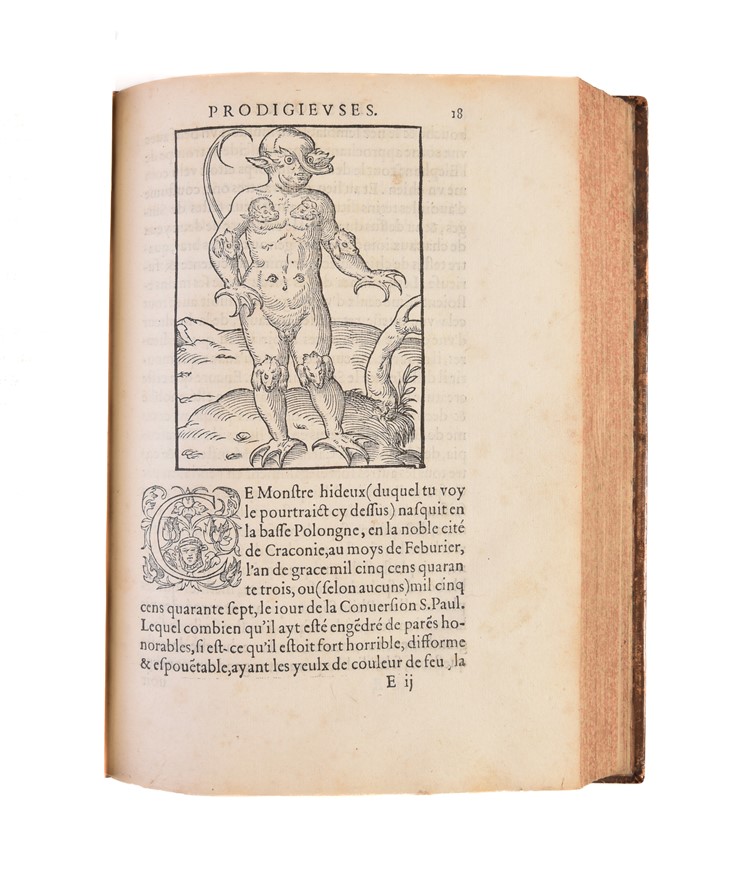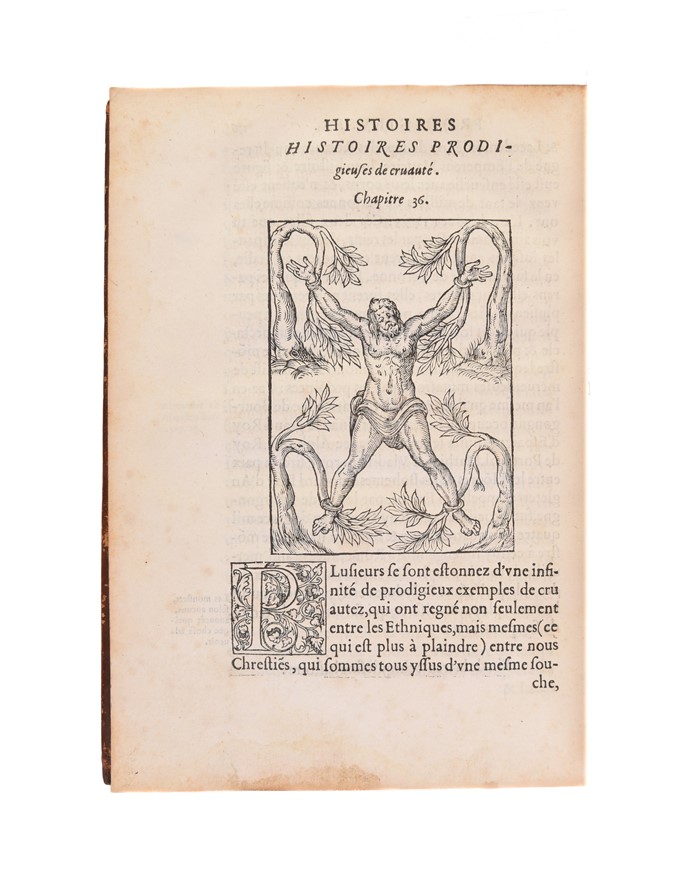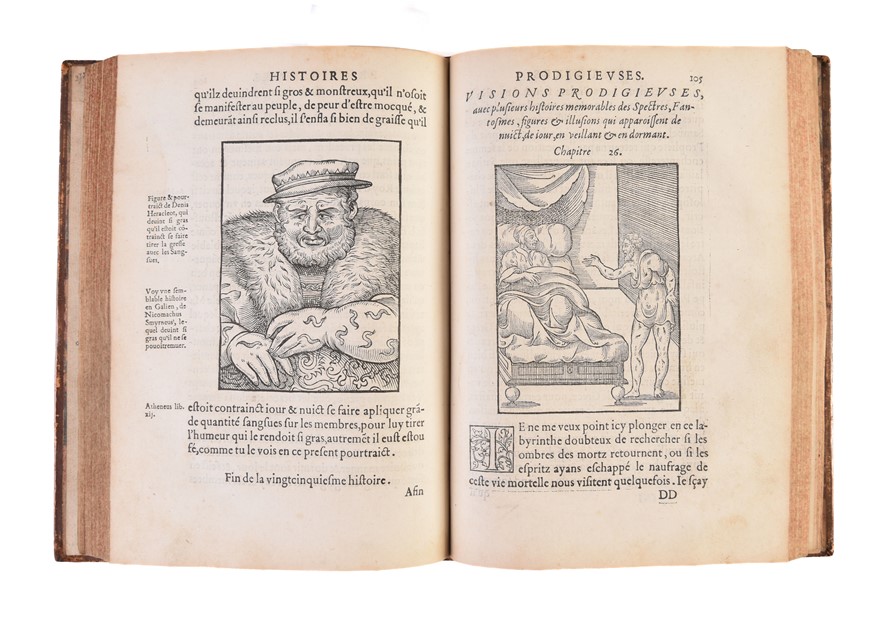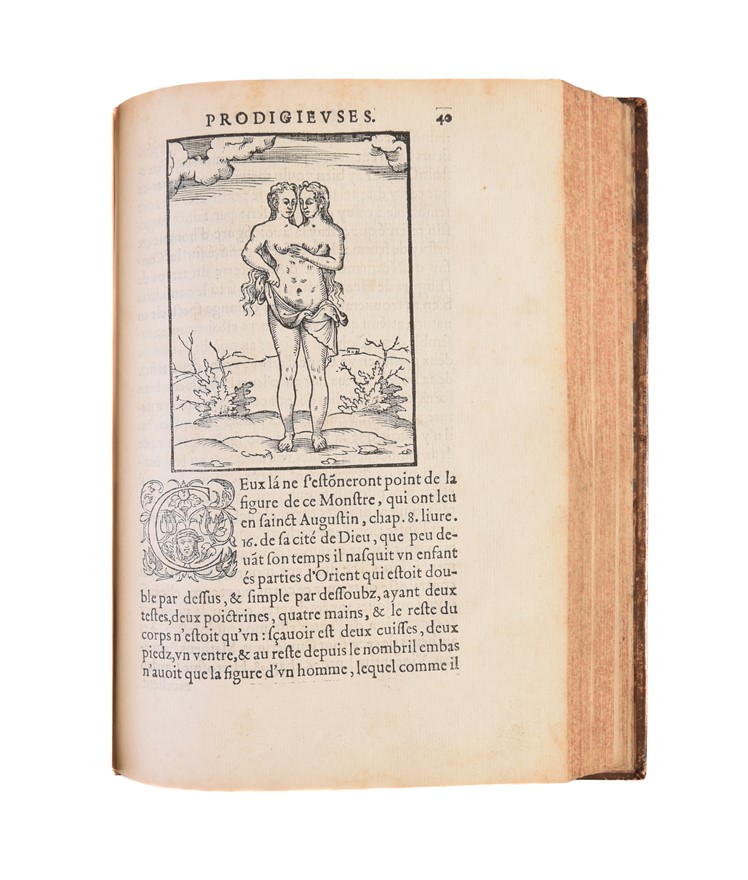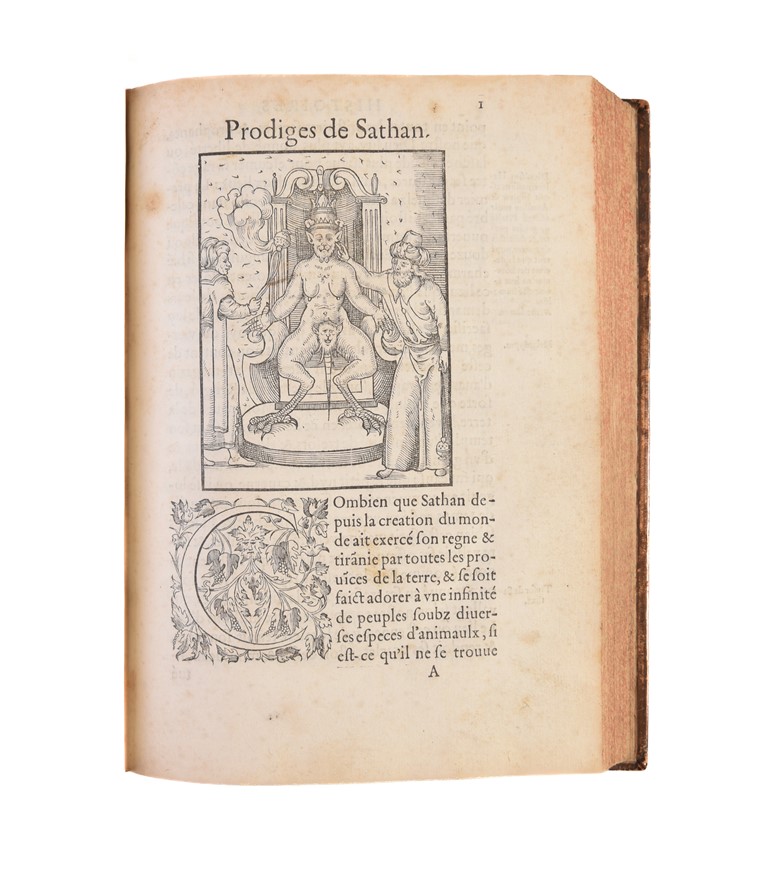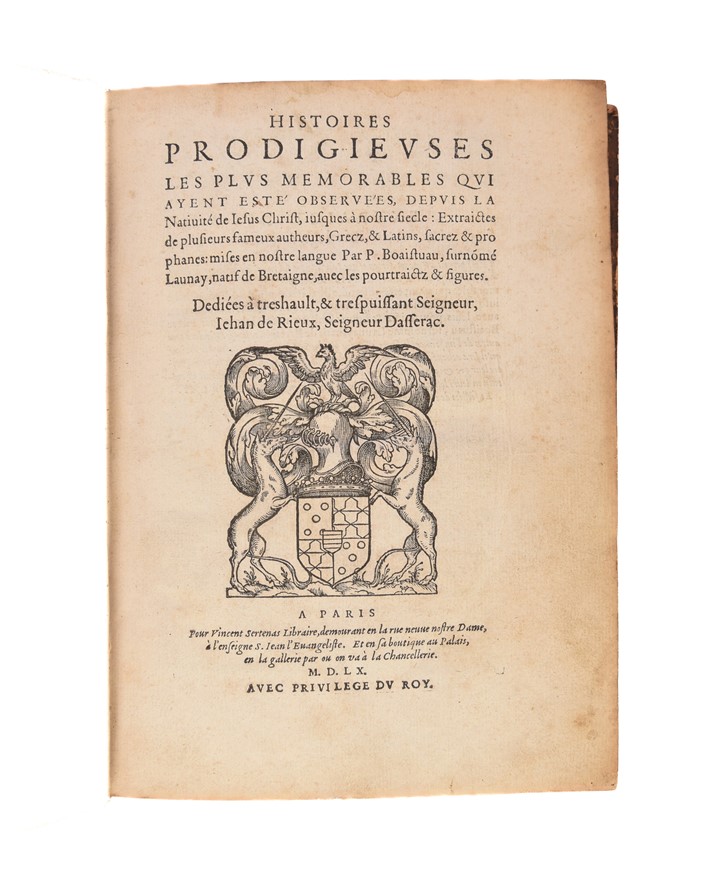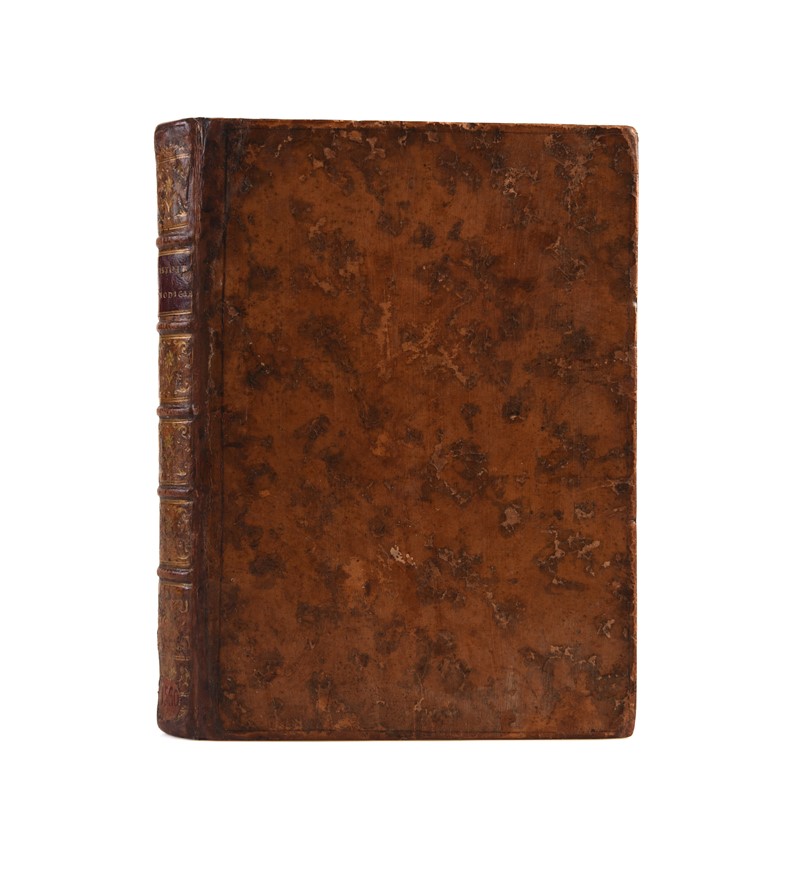Histoires prodigieuses... extraictes de plusieurs fameux autheurs, Grecs & Latins, sacrez & prophanes: mises en nostre langue par P. Boaistuau, surnomé Launay, natif de Bretagne: avec les pourtraicts & figures.Paris,
BOAISTUAU Pierre (1560.)
£10000.00
Please contact us in advance if you would like to view this book at our Curzon Street shop.
MONSTERS AND PORTENTS, LAVISHLY ILLUSTRATED FIRST EDITION
Fine woodcut arms of the dedicatee Jean de Rieux on title-page and 49 almost full-page woodcuts (105 x 75mm) of monsters and prodigious events; fine large foliated and grotesque initials.
4to (220 x 157mm). [24], 173, [5]pp (lacking final blank). Eighteenth-century mottled calf, spine gilt in compartments with repeated floral motif, red morocco label in second compartment with title in gilt, pink sticker with date '1560' at foot, marbled endpapers (sympathetic repairs to joints, headcaps and extremities, minor scuffs and scratches, larger patch of wear on upper board).
Paris: Vincent Sertenas,
First edition of this wonderful, illustrated compendium of fantastic stories by writer, editor and translator Pierre Boaistuau (c.1520-1566). Each of the forty chapters here explores the weird and wonderful, monstrous and grotesque; from supernatural events and portents, to omens and various wondrous phenomena. Extremely wide-ranging, the stories here are drawn from a wide variety of biblical, folkloric and classical sources; Boaistuau is at pains to point out the breadth of his source material in his introduction to readers, as well as its scientific merit.
Amongst the wondrous and supernatural monstres described here are creatures of the deep (pp.54-64); the satyr, that appeared to St Anthony in the desert (p.41), resembling a man but with a 'hideous hooked nose, two horns, and cloven goat's hooves'; a seven-headed serpent bought by the Venetians in Africa (Chapter 32, pp.1140-148); a footless bird (Chapter 34); and others. Boaistuau also recounts historical and contemporary events. Chapter 11 recounts the death of Pliny and the eruption of Vesuvius (pp.34-36); Chapter 25 gives an account of 'Banquetz Prodigieux', extraordinary displays of gluttony and profligacy, drawn from historical sources (pp.96-104), and ending with a woodcut portrait of Denis Heracleot, a fabled ancient tyrant who attempted to lose weight by using leeches. Chapter 8 describes 'a man of our times who washes his face and hands in molten lead' (pp.27-29). Frequently the contemporary and fantastical overlap; chapter 7 describes a 'horrible monster de nostre temps', born in Krakow in February, 1543, with eyes the colour of fire, the trunk of an elephant, the heads of four dogs at its elbows and knees, and webbed hands and feet. Chapter 27 describes two, two-headed figures, one of which is reported to have existed in Italy in 1540, by Venetian classicist Lodovico Ricchieri.
Boaistuau's work is a prime example of the growing number of 'wonder books' being published in this period, that placed accounts of monstrous beings or wondrous events in their social, political and religious context. 'Wonder books promoted debates on issues including the correct interpretation of God's plans for the world; the natural yet simultaneously supernatural meaning of wondrous and terrible signs; the likely timing of the Last Days; and the activities of the Devil. In France, wonder books appeared primarily during the sixteenth-century Wars of Religion that began in 1562 and continued intermittently but persistently until 1598, pitting different social, political and religious groups - especially Calvinists and Catholics - against each other in a civil conflict of unprecedented scope.' (J. Spinks, 'Print and polemic in sixteenth-century France: the Histoires Prodigieuses, confessional identity, and the Wars of Religion', Renaissance Studies 27.1, 2013, p.73).
Portents were viewed as indications of divine wrath, monstrous births as punishments for human sin, and even the justified consequence of political upheaval; here, for example, Boaistuau "correlates the birth of a monstrous child, born with four arms and four legs, with the 1355 peace treaty between Venice and Genoa, which occurred the day the child was supposedly born" (see Plater & Bould, 'Pierre Boaistuau, Histoires Prodigieuses', [University of Melbourne; open access]).
'Le livre de Boaistuau est un livre d'images'; that the woodcuts in this volume are an integral part of Boaistuau's work and directly correspond to the text is evident from his extensive, direct reference to the illustrations that accompany each chapter. They are extremely close to the stunning illuminations that adorn Boaistuau's own manuscript copy of the work, presented by him, in person, to Elizabeth I of England just a year before, in 1559 (now held at the Wellcome, MS.136); 39 of the 42 illustrations in the manuscript copy are present in this edition (Bamforth, 'Introduction', p.108). In turn, several of those illuminations and thus the woodcuts present in this edition are based closely on those in other works of the same genre, printed and popular around the same time: the woodcut illustration of the monster of Krakow is based on that in Sebastian Münster's Cosmographia (Basel: Henricus Petri, 1552); that of the seven-headed serpent can be found in Lycosthenes, Prodigiorum ac ostentorum chronicon (Basel, Petri, 1557), among others. As Mortimer notes, the woodblocks for the illustrations in the present work were well-designed, and by the following year Jacques Macé has copied the set and soon at least three versions of the blocks had been used in editions in Paris, Antwerp and London (Mortimer, French, 103). One woodcut, on p.124 is signed 'G'.
Title leaf a little dusty, some staining to final leaf, otherwise a lovely copy.
Provenance: 1. Annotations in an early hand in Chapter XV, on precious gems, and Chapter XXIII, on the properties of plants. 2. Exlibris of Belgian writer and poet Daniel Berditchevsky (1925-2020) on front pastedown.
Caillet, 1250. Mortimer, French, 103. BMSTC (French), p.70. S. Bamforth (ed.), Histoires Prodigieuses: édition de 1561: édition critique (Geneva, Librairie Droz, 2010), no.1a.
OCLC: US: Cornell, Yale, Princeton, Cleveland, Boston College, Harvard. UK: Oxford, V&A.
Stock Code: 246659
